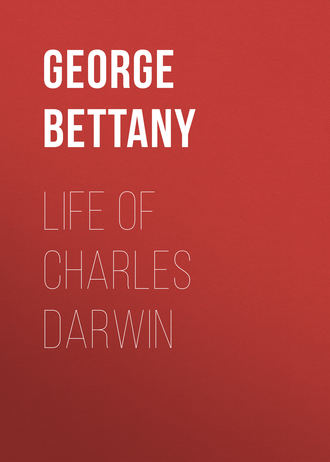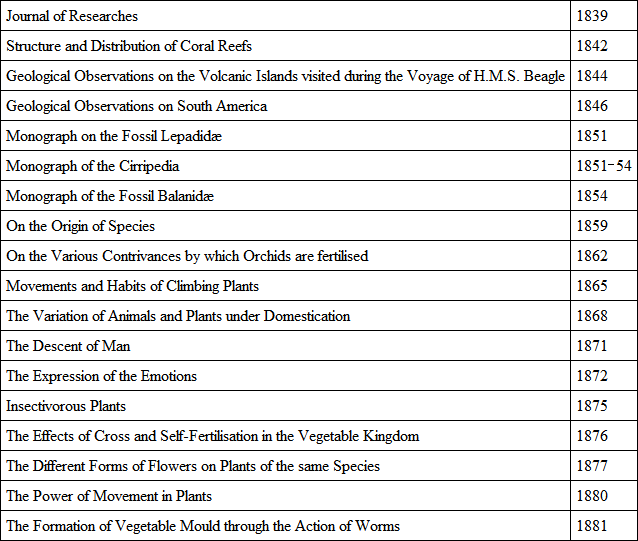 полная версия
полная версияLife of Charles Darwin
– What is? Nation, by A. Gray, vol. 18, 1874, pp. 348-351; reprinted in Darwiniana, by Asa Gray, 1876.
IV. – CHRONOLOGICAL LIST OF WORKS
1
This is the Erasmus Earle who forms the subject of “A Lawyer’s Love Letters,” in The National Review, February, 1887. Letters of his are also printed in the Tenth Report of the Historical MSS. Commission.
2
“The house is seen,” says Mr. Woodall, “from the line immediately beyond the low tower of St. George’s Church. Visitors who make a pilgrimage there, after crossing the Welsh Bridge, follow the main street until St. George’s Church is passed, and the continuous line of houses ceases. The next carriage drive, on the right, cutting in two a lofty side-walk, is the entrance to The Mount. A short street of new houses, near St. George’s Church, has been called ‘Darwin Street;’ as yet the only public recognition in the town of the greatest of Salopians. A memorial of a more private character has been placed in the Unitarian Chapel, in the form of a tablet bearing the following inscription: – ‘To the memory of Charles Robert Darwin, author of “The Origin of Species,” born in Shrewsbury, February 12th, 1809. In early life a member and constant worshipper in this church. Died April 19th, 1882.’ Mrs. Darwin, we believe, was not strict in her adhesion to the communion in which she had been brought up, but often attended St. Chad’s Church, where Charles and his brother were baptized.”
3
This statement by Darwin disposes of Mr. Grant Allen’s assertion that geology was Darwin’s “first love” (p. 36). He reckoned himself an entomologist when he went to Cambridge, and certainly Mr. Ainsworth’s statement shows that he was a naturalist in a wide sense while at Edinburgh. C. V. Riley, the well-known American entomologist, says (Proceedings of the Biological Society of Washington, U.S., vol. i., 1882, p. 70) “I have the authority of my late associate editor of The American Entomologist, Benjamin Dann Walsh, who was a class-mate of Darwin’s at Cambridge, that the latter’s love of natural history was chiefly manifested, while there, in a fine collection of insects.” Indeed, he was one of the original members of the Entomological Society of London, founded in 1833, and showed an active interest in its affairs throughout life, being elected a member of its council in 1838. As early as January 4, 1836, a memoir based on insects sent home by Darwin from Chiloe, was read before the Society by Charles Babington, now Professor of Botany at Cambridge.
4
Mr. Grant Allen (“Darwin,” p. 42) states that Darwin observed sixty-seven distinct organic forms in the fine dust which fell on deck. It was Ehrenberg who determined these organisms in dust sent to him by Darwin, and four out of five of the packets of dust sent to Ehrenberg were given to Darwin by Lyell (Darwin’s Journal, second edition, p. 5).
5
Mr. John Murray’s views, derived from the experience acquired in the voyage of the Challenger, and published in 1880, tend to modify Darwin’s conclusions to some extent. Mr. Murray says that it is now shown that many submarine mountains exist, which are usually volcanic, and which, being built upon by various forms of shell-bearing animals, could be raised to such a level that ordinary corals could build upon them. He concludes that probably all atolls are seated on submarine volcanoes, and thus it is not necessary to suppose such extensive and long-continued subsidences as Darwin suggested. This view is also in harmony with Dana’s views of the great antiquity and permanence of the great ocean basin. See “The Structure and Origin of Reefs and Islands.” By John Murray; Proc. Roy. Soc., Edin., x. 505-18 (abstract); also Nature, xxii. 351-5.
6
[Back to reference on pg. 14] It is worth while to reproduce here a few sentences from Erasmus Darwin’s “Zoonomia,” showing how acutely he guessed in the direction of evolution.
“When we revolve in our minds, first, the great changes which we see naturally produced in animals after their nativity… Secondly, when we think over the great changes introduced into various animals by artificial or accidental cultivation… Thirdly, when we enumerate the great changes produced in the species of animals before their nativity… Fourthly, when we revolve in our minds the great similarity of structure which obtains in all the warm-blooded animals… Fifthly, from their first rudiment or primordium to the termination of their lives, all animals undergo perpetual transformations, which are in part produced by their own exertions;… and many of these acquired forms or propensities are transmitted to their posterity… A great want of one part of the animal world has consisted in the desire of the exclusive possession of the female; and these have acquired weapons to combat each other for this purpose… The final cause of this contest amongst the males seems to be that the strongest and most active animal should propagate the species, which should thence become improved. Another great want consists in the means of procuring food, which has diversified the forms of all species of animals… All which seem to have been gradually produced during many generations by the perpetual endeavour of the creatures to supply the want of food, and to have been delivered to their posterity with constant improvement of them for the purpose required… The third great want among animals is that of security, which seems much to have diversified the forms of their bodies and the colour of them… The contrivances for the purposes of security extend even to vegetables… Would it be too bold to imagine that in the great length of time since the earth began to exist … all warm-blooded animals have arisen from one living filament, which the Great First Cause endued with animality;… possessing the faculty of continuing to improve by its own inherent activity, and of delivering down those improvements by generation to its posterity, world without end!”
7
In this study Darwin came into communication, as early as 1839, with the Hon. and Rev. W. Herbert, afterwards Dean of Manchester, and received from him a personal account of his experiments on hybrids. It was Herbert who, as early as 1822, in the fourth volume of the “Horticultural Transactions,” and in his work on the Amaryllidaceæ, 1837, declared that horticultural experiments have established, beyond the possibility of refutation, that botanical species are only “a higher and more permanent class of varieties.” He extended the same view to animals, and believed that single species of each genus were originally created in a highly plastic condition, and that these have produced, chiefly by intercrossing, but also by variation, all our existing species.
8
The first portion of this important letter is quoted from the English translation of Haeckel’s “History of Creation,” 1876; the second portion from O. Schmidt’s “Doctrine of Descent and Darwinism,” having been re-written by Darwin from the German text.
9
Mr. Romanes, in his paper on “Physiological Selection” (Journal of the Linnean Society, Zoology, xix. 337-411), has entered upon a most important discussion of this question.
10
The full text of a large part of Darwin’s original chapter on Instinct, which was omitted from the “Origin of Species” for the sake of condensation, is published in Mr. Romanes’ “Mental Evolution in Animals,” 1883, which also contains many other observations by Darwin.
11
The reader will thus be able to judge for himself how far Darwin’s “Origin of Species” gained, “from the very first outset, universal respect and a fair hearing,” as Mr. Grant Allen, with singular forgetfulness, states (“Darwin,” p. 112). The violence of the attacks made upon Darwin by the majority of religious and orthodox journals is well known.
12
G. J. Romanes, in “Charles Darwin,” memorial notices reprinted from Nature.
13
Round Table Series. “Charles Darwin” (1886), by J. T. Cunningham.


